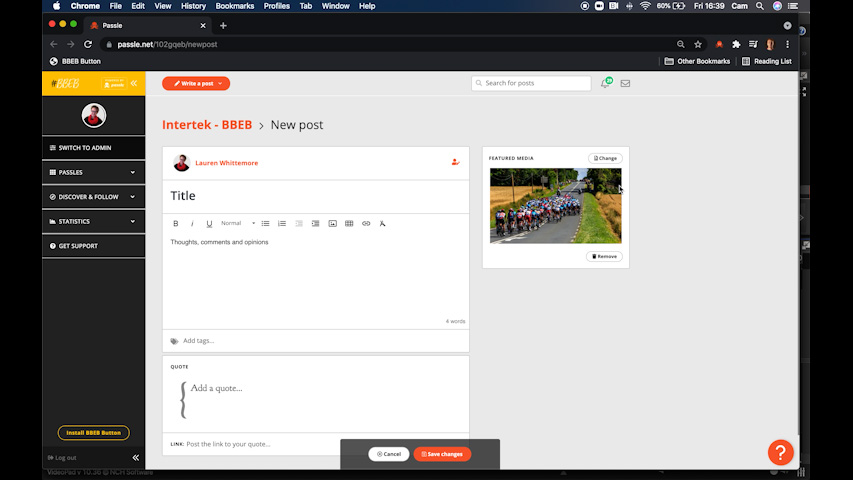Sure, you’ve heard the dangers of sitting all day, but with most jobs there isn’t much you can do about it, right?
Not according to a new study, which looked into the impacts of prolonged sitting.
Five minutes of light walking every half hour can help alleviate some of the increased risk that comes with sitting for long stretches of the day, according to the study published Thursday in the journal of the American College of Sports Medicine.
The scientific community has known for decades that sitting can increase risk of chronic diseases like diabetes, heart disease and certain types of cancers, said Keith Diaz, the study’s lead author and assistant professor of behavioral medicine at Columbia University Medical Center. But until now there haven’t been clear guidelines about how long you can sit and how often you should be moving.
“We’ve known for probably about a decade now that sitting increases your risk for most chronic diseases and increases your risk for early death,” said Diaz, who is also director of the Exercise Testing Laboratory at the university’s Center for Behavioral Cardiovascular Health. “Just like how much fruits and vegetables they should eat and how much exercise they should do, we need to give (people) specific guidance on how to combat the harms of sitting.”
The walk can be as light as 1.9 miles per hour, which is slower than most people walk normally, Diaz said. The goal is to just break up the sitting with some movement.
Several health markers were measured for different combinations of periods spent sitting and walking for this study. Although the sample size was small, the study was rigorous with strong methodology, said Matthew Buman, director of the College of Health Solutions at Arizona State University. Buman was not involved in the study,
Scientists don’t yet know exactly why sitting is so bad, but the working theory is that muscles are important in regulating things like blood sugar and cholesterol levels. But when you sit for too long, your muscles don’t have the opportunity to contract and operate optimally, Diaz said.
Does five minutes every half hour still seem like a stretch? Even little “activity snacks” like one minute of walking every hour was shown to reduce blood pressure in study participants by a “sizable amount,” Diaz said.
And all the participants in the study were generally healthy adults, meaning that those with chronic conditions may see an even greater benefit, Buman said.
Why your boss should greenlight it
Even with clearer guidelines, moving regularly may still seem unattainable
“There are so many of us who lead inactive or sitting-based lifestyles or have sitting-based jobs,” Diaz said. “There are these social norms where if you are up out of your desk, people think you’re not working.”
Diaz has been working to convince employers of the importance of moving during the workday – not only for individual health, but for the bottom line, too.
“Sitting is an occupational hazard and a healthy employee is a more productive employee,” he said.
The team found that there were more than just physical health benefits for participants who broke up their sitting. They also found that it reduced fatigue and improved mood, Diaz said.
“Just sitting at your desk and grinding away for 8 hours actually may not be all that great if you’re just concerned about the bottom line about your work productivity,” he added.
And although standing desks are popular, they may not be the answer.
“I’m not sure there’s really solid scientific evidence that standing is really any better than sitting,” Diaz said. “I worry that people have this false sense that they are healthy because they are using this desk, and maybe they’re not actually that much better.”
How to move more at work
What Diaz really wants people to take away from the research is that getting enough movement is achievable.
Moving doesn’t have to mean leaving your desk if that’s not in your workplace culture, said CNN fitness contributor Dana Santas, a mind-body coach for professional athletes.
The most recent research only looked at the effectiveness of walking, but Santas said there are other ways to move your muscles regularly.
“You can simply practice box squats by getting up and sitting back down gently then popping right back up again and repeating that motion over and over,” Santas said via email.
If you do have the opportunity to get more space, Santas loves to recommend a dance break.
“Since most songs average at least 3 minutes, you can dance off the negative impact of too much sitting. And, as a bonus — dancing to your favorite tunes will also boost your mood!” she said.
For people with limited mobility or who use wheelchairs, there are still accessible ways to break up sedentary times.
Everyone should stretch out and move hands in all directions, Santas said. And someone in a wheelchair can do stretches, sidebends and twisting exercises from the chair, she added.
“Even when you can’t move your lower body and actually get up from sitting, actively taking deep breaths that use your diaphragm and move your ribs, is beneficial for your posture and overall health,” Santas said.
“The overall message is to move in as many ways that are possible based on your abilities,” Buman said.
The bar for movement doesn’t have to be high, Diaz added. “To the extent that you can break up your sitting with some kind of movement breaks, you’re still going to yield some benefit,” he said.
 unknownx500
unknownx500
















